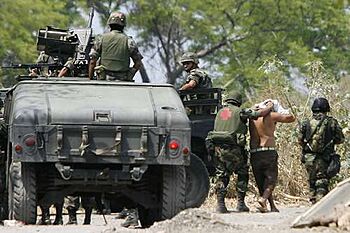Mexican drug war facts for kids
Quick facts for kids Mexican drug war |
|||||||
|---|---|---|---|---|---|---|---|
| Part of the war on drugs | |||||||
 The Mexican military detaining suspects in Michoacán, 2007 |
|||||||
|
|||||||
| Belligerents | |||||||
Consulting and training support by:
Guerrilla groups: |
Mexican cartels:
Weakened and defunct cartels: |
||||||
| Commanders and leaders | |||||||
|
|
||||||
| Strength | |||||||
|
Cartels:
|
||||||
| Casualties and losses | |||||||
|
Cartels:
|
||||||
Total casualties:
|
|||||||
The Mexican drug war is an ongoing conflict in Mexico. It is mainly between the Mexican government and powerful groups involved in illegal activities. These groups are often called cartels. This conflict has caused a lot of fighting, problems with trust in government, and big changes in society.
The conflict officially started in December 2006. At that time, President Felipe Calderón sent the military to fight against the violence caused by these groups. The government wanted to break up these powerful organizations that had grown strong across the country.
President Calderón's plan was to use thousands of soldiers to directly fight the groups. Some people have said that this approach, using the military, actually made the fighting worse. Later presidents have continued this strategy with different levels of success.
In December 2018, President Andrés Manuel López Obrador said the "war on drugs" was over. However, fighting has continued, and the number of killings remains high. Critics say that simply saying the war is over does not fix the main problems causing the conflict.
What Happened After the Conflict Started
The conflict has made problems with trust in government and police worse. Many officials have been influenced by these powerful groups. This makes it harder for people to trust their leaders.
The fighting has caused a lot of suffering for regular people. Many have had to leave their homes, and many lives have been lost. A large number of people have also disappeared in Mexico since the conflict began. Experts believe that over 431,000 people have died. Tens of thousands more are missing. By 2013, it was thought that at least 120,000 people had died because of the conflict.
See also
- Narcoculture in Mexico
- 2011 Mexican protests
- 2011–12 in the Mexican drug war
- Borderland Beat
- Mérida Initiative
- Uppsala Conflict Data Program
- List of ongoing armed conflicts
- List of journalists and media workers killed in Mexico

